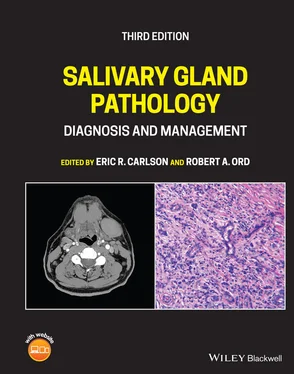621 617
622 618
623 619
624 620
625 621
626 622
627 623
628 624
629 625
630 626
631 627
632 628
633 629
634 630
635 631
636 632
637 633
638 634
639 635
640 636
641 637
642 638
643 639
644 640
645 641
646 642
647 643
648 644
649 645
SALIVARY GLAND PATHOLOGY
DIAGNOSIS AND MANAGEMENT
Third Edition
Edited by
Eric R. Carlson
University of Tennessee Graduate School of Medicine,
University of Tennessee Cancer Institute,
Knoxville, TN, United States
Robert A. Ord
University of Maryland Medical Center,
Greenbaum Cancer Institute, Baltimore, MD,
United States

This edition first published 2022
© 2022 John Wiley & Sons, Inc.
Edition History Wiley‐Blackwell (1e, 2008); John Wiley & Sons, Inc. (2e, 2016)
All rights reserved. No part of this publication may be reproduced, stored in a retrieval system, or transmitted, in any form or by any means, electronic, mechanical, photocopying, recording or otherwise, except as permitted by law. Advice on how to obtain permission to reuse material from this title is available at http://www.wiley.com/go/permissions.
The right of Eric R. Carlson and Robert A. Ord to be identified as the authors of the editorial material in this work has been asserted in accordance with law.
Registered Office John Wiley & Sons, Inc., 111 River Street, Hoboken, NJ 07030, USA
Editorial Office
111 River Street, Hoboken, NJ 07030, USA
For details of our global editorial offices, customer services, and more information about Wiley products visit us at www.wiley.com.
Wiley also publishes its books in a variety of electronic formats and by print‐on‐demand. Some content that appears in standard print versions of this book may not be available in other formats.
Limit of Liability/Disclaimer of Warranty The contents of this work are intended to further general scientific research, understanding, and discussion only and are not intended and should not be relied upon as recommending or promoting scientific method, diagnosis, or treatment by physicians for any particular patient. In view of ongoing research, equipment modifications, changes in governmental regulations, and the constant flow of information relating to the use of medicines, equipment, and devices, the reader is urged to review and evaluate the information provided in the package insert or instructions for each medicine, equipment, or device for, among other things, any changes in the instructions or indication of usage and for added warnings and precautions. While the publisher and authors have used their best efforts in preparing this work, they make no representations or warranties with respect to the accuracy or completeness of the contents of this work and specifically disclaim all warranties, including without limitation any implied warranties of merchantability or fitness for a particular purpose. No warranty may be created or extended by sales representatives, written sales materials or promotional statements for this work. The fact that an organization, website, or product is referred to in this work as a citation and/or potential source of further information does not mean that the publisher and authors endorse the information or services the organization, website, or product may provide or recommendations it may make. This work is sold with the understanding that the publisher is not engaged in rendering professional services. The advice and strategies contained herein may not be suitable for your situation. You should consult with a specialist where appropriate. Further, readers should be aware that websites listed in this work may have changed or disappeared between when this work was written and when it is read. Neither the publisher nor authors shall be liable for any loss of profit or any other commercial damages, including but not limited to special, incidental, consequential, or other damages.
Library of Congress Cataloging‐in‐Publication Data applied for [ISBN: 9781119730187]
Cover image:
Cover design by
Eric R. Carlson, DMD, MD, EdM, FACS
Department of Oral and Maxillofacial Surgery, University of Tennessee Graduate School of Medicine, University of Tennessee Cancer Institute, Knoxville, TN, USA
Robert A. Ord, BDS, MB BCh (Hons), FRCS, FACS, MS, MBA
Department of Oral and Maxillofacial Surgery, University of Maryland Medical Center, Greenbaum Cancer Institute, Baltimore, MD, USA
Katherine George, BDS, BSc, MBBS, MFDS RCS (Eng), FRCS (OMFS)
Oral and Maxillofacial Surgeon, Kings College Hospital NHS Foundation Trust, Denmark Hill, London, UK
Pradeep Jacob, MD, MBA
Private Practice of Radiology, Chattanooga, TN, USA
Joseph Kelley, MD, PhD
Director of Clinical Research, GenesisCare USA of North Carolina
Lara Kujtan, MD, MSc
Department of Medicine, University of Missouri at Kansas City, Kansas City, MO, USA
John D. Langdon, FKC, MB BS, BDS, MDS, FDSRCS, FRCS, FMedSci
Department of Maxillofacial Surgery, King’s College, London, England
J. Michael McCoy, DDS
Departments of Oral and Maxillofacial Surgery, Pathology, and Radiology, University of Tennessee Graduate School of Medicine, Knoxville, TN, USA
Mark McGurk, BDS, MD, FRCS, DLO, FDS, RCS
Head and Neck Academic Center, Department of Head and Neck Surgery, University College London Hospital, London, UK
Max Ofori, MD
Division of Radiation Oncology, University of Tennessee Medical Center, Knoxville, TN, USA
John J. Sauk, DDS, MS, FAAAS, FAHNS
School of Dentistry, University of Louisville, Louisville, KY, USA
Janikiraman Subramanian, MD
Department of Medicine, Thoracic Oncology and Center for Precision Oncology, Saint Luke’s Cancer Institute, University of Missouri at Kansas City, Kansas City, MI, USA
Randy Todd, DMD, MD, DSc
Private Practice of Oral and Maxillofacial Surgery (retired), Peabody, MA, USA
Michael D. Turner, DDS, MD, FACS
Division of Oral and Maxillofacial Surgery, Mount Sinai Hospital, Icahn Mount Sinai School of Medicine, New York, NY, USA
The mention of “head and neck cancer” immediately connotes the sobering realities and potentials of oral squamous cell carcinoma. Left to secondary recollection and awareness is the significance of salivary gland malignancy. The same can be said for the general perception of benign salivary neoplasia. In this brilliant new textbook, authors Carlson and Ord correct these notions, focusing proper emphasis on the group of diseases which, in their malignant form, represent some three percent of all North American head and neck tumors, affecting a minimum of 2500 victims per year.
One marvels at the dedication, energies, and resources – to say nothing of the expertise – mustered to produce a volume of this depth and expanse. While almost forty percent of the effort is directed toward the vitally significant elements of classification, diagnosis, and clinical care of neoplasia, there is more – much more – here, for both the training and practicing readerships. The whole array of salivary gland dysfunctions is marvelously displayed in meaningful clinical color, in easily grasped sketches and graphs, and in well‐chosen descriptive imaging. From the mandatory fundaments for such an undertaking – John Langdon's discourse on macro‐ and microanatomy, Pradeep Jacob's presentation on imaging diagnostics (45 pages!), John Sauk's explanations of current classification and staging of tumors – to the surgical demonstrations of pathology, anatomy, and technique, the visual material is extraordinary.
Читать дальше













